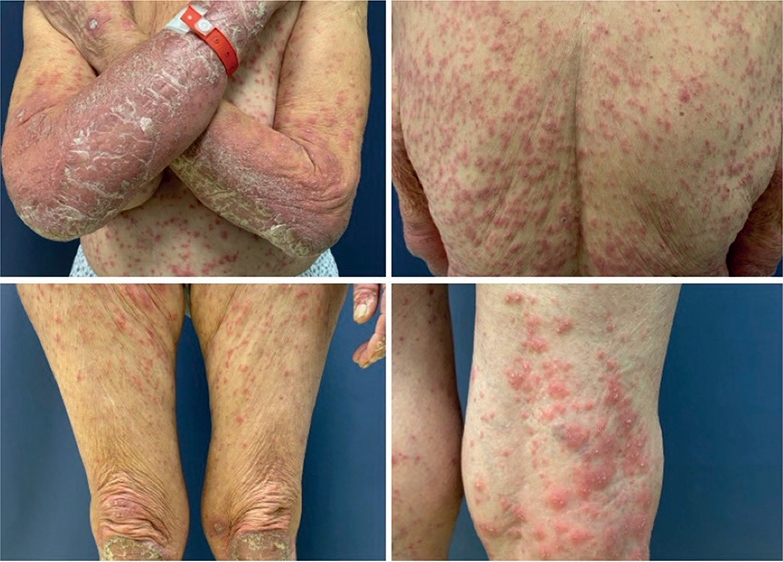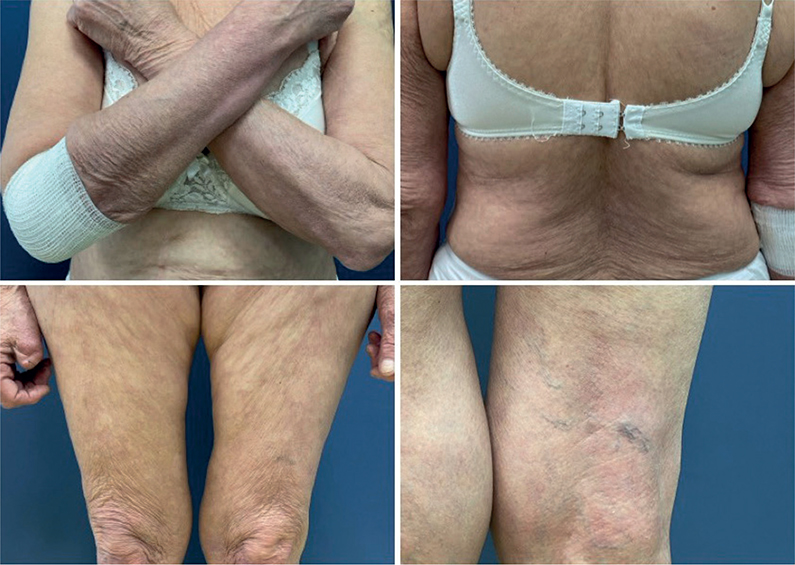SHORT COMMUNICATION
Denosumab-induced Acute Generalized Exanthematous Pustulosis
Maruška MAROVT* and Pij B. MARKO
Department of Dermatology and Venereology, University Medical Centre Maribor, Ljubljanska 5, SI-2000 Maribor, Slovenia. *E-mail: maruska.marovt@ukc-mb.si
Citation: Acta Derm Venereol 2024; 104: adv40430. DOI: https://doi.org/10.2340/actadv.v104.40430.
Copyright: © 2024 The Author(s). Published by MJS Publishing, on behalf of the Society for Publication of Acta Dermato-Venereologica. This is an Open Access article distributed under the terms of the Creative Commons Attribution-NonCommercial 4.0 International License (https://creativecommons.org/licenses/by-nc/4.0/).
Submitted: Mar 27, 2024. Accepted after revision: Jun 24, 2024. Published: Aug 23, 2024
Competing interests and funding: MM has served as a paid speaker, investigator, and/or advisory board member for Janssen, Novartis, Boehringer Ingelheim, AbbVie, Amgen,EliLilly, and Medis. PBM has no conflict of interest to declare.
INTRODUCTION
Acute generalized exanthematous pustulosis is a rare pustular skin eruption that is usually caused by medication. The patient with known plaque psoriasis had extensive pustules on the trunk and extremities. We report the case of a patient with denosumab-induced acute generalized exanthematous pustulosis. Generalized pustular psoriasis is discussed as the most important differential diagnosis.
CASE REPORT
A 72-year-old woman presented with a 3-day history of extensive pustular skin lesions without systemic symptoms. Two days prior to the appearance of the skin lesions, she received the first dose of denosumab due to osteoporosis. She had had moderate to severe plaque psoriasis for 50 years, which had been treated with methotrexate for some time in the past.
Skin revealed 2 types of lesions: first, extensive pustules on the trunk and extremities and second, extensive plaques on the extensor sides of the arms, legs, and lower back, affecting approximately 15% of the body surface area (BSA) (Fig. 1). Nothing abnormal was found on physical examination. Blood examination revealed leucocytosis (14.76 × 109/L), neutrophilia (13.08 × 109/L), and a high level of C-reactive protein (135 mg/L), while serum calcium, albumin, and other biochemical values were within the normal range. The chest X-ray and urinalysis were unremarkable. A throat culture was negative. A skin biopsy was performed, which showed a slightly acanthotic epidermis with focal parakeratosis and the formation of extensive intracorneal neutrophilic pustules. The dermis showed a moderately intense superficial and perivascular mixed-cellular infiltrate with predominantly neutrophilic granulocytes. Two working diagnoses were made: drug-induced generalized pustular psoriasis (GPP) and acute generalized exanthematous pustulosis (AGEP). Therapy with a strong topical corticosteroid was started, and a remarkable improvement was observed within a week. After the prompt clinical improvement, AGEP was more likely, so we advised our patient not to continue treatment with denosumab and started risankizumab due to underlying moderate to severe plaque psoriasis. After 4 months of therapy, no more pustular lesions or plaques were observed (Fig. 2), and this remained the case after 1 year.

Fig. 1. Extensive pustules and plaques on the trunk and extremities.

Fig. 2. Resolved lesions after 4 months.
DISCUSSION
In the vast majority of cases, AGEP is caused by drugs, most commonly pristinamycin, beta-lactam antibiotics, quinolones, antimalarials, sulphonamides, macrolides, calcium channel blockers, and terbinafine (1). The pathogenesis of AGEP includes drug-specific T-cell infiltrates with neutrophil accumulation mediated by IL-8 and GM-CSF, Th17 cells involved in neutrophil activation, and IL36RN mutations present in some patients (2). Skin lesions are usually observed 24–48 h after drug ingestion, and laboratory findings may include lymphocytosis with neutrophilia, hypocalcaemia, and eosinophilia. Symptoms usually resolve within 2 weeks (1). There are no reports of AGEP induced by denosumab or other bisphosphonates. However, 1 case of acute localized exanthematous pustulosis, which is considered an unusual form of AGEP, has been reported with alendronate (3).
The main differential diagnosis in our case was GPP, as it is clinically and histopathologically similar, but AGEP usually improves faster (1). GPP is a rare severe skin disease that typically begins in adulthood and is more common in women (4). Pustules can be recurrent or persistent. Treatment options include spesolimab, the only GPP-specific treatment, cyclosporine, retinoids, infliximab, and methotrexate as first-line therapies, based on very weak evidence. Otherwise, there are reports of effective treatment with various biologics, including certolizumab pegol, risankizumab, adalimumab, guselkumab, secukinumab, brodalumab, and ixekizumab. According to the definition, recurrent relapses are required to make the diagnosis and 53–65% of GPP patients also have concurrent plaque psoriasis (5). Our patient may have had a first flare of drug-induced GPP or AGEP due to denosumab. Due to the rapid improvement AGEP was more likely. No new lesions were observed, but a possible flare-up of GPP could be prevented by risankizumab, which is approved in Japan (5).
To our knowledge, this is the first case of denosumab-induced AGEP, and the first flare-up of GPP presented a difficult differential diagnosis. Identification of specific biomarkers would improve early diagnosis and management when clinicians are dealing with generalized pustular skin lesions.
ACKNOWLEDGEMENTS
Informed consent has been obtained from the patient.
REFERENCES
- Stadler PC, Oschmann A, Kerl-French K, Maul JT, Oppel EM, Meier-Schiesser B, et al. Acute generalized exanthematous pustulosis: clinical characteristics, pathogenesis, and management. Dermatology 2023; 239: 328–333. https://doi.org/10.1159/000529218
- Sussman M, Napodano A, Huang S, Are A, Hsu S, Motaparthi. Pustular psoriasis and acute generalized exanthematous pustulosis. Medicina (Kaunas) 2021; 57: 1004. https://doi.org/10.3390/medicina57101004
- Bautista-Villanueva S, Galleani C, Barranco R, Bellón T, Blanco M, García-Moguel I. Acute localized exanthematous pustulosis due to alendronate. J Investig Allergol Clin Immunol 2021; 32: 69–70. https://doi.org/10.18176/jiaci.0709
- Bachelez H, Barker J, Burden AD, Navarini AA, Krueger JG. Generalized pustular psoriasis is a disease distinct from psoriasis vulgaris: evidence and expert opinion. Expert Rev Clin Immunol 2022; 18: 1033–1047. https://doi.org/10.1080/1744666X.2022.2116003
- Kodali N, Blanchard I, Kunamneni S, Lebwohl MG. Current management of generalized pustular psoriasis. Exp Dermatol 2023; 32: 1204–1218. https://doi.org/10.1111/exd.14765